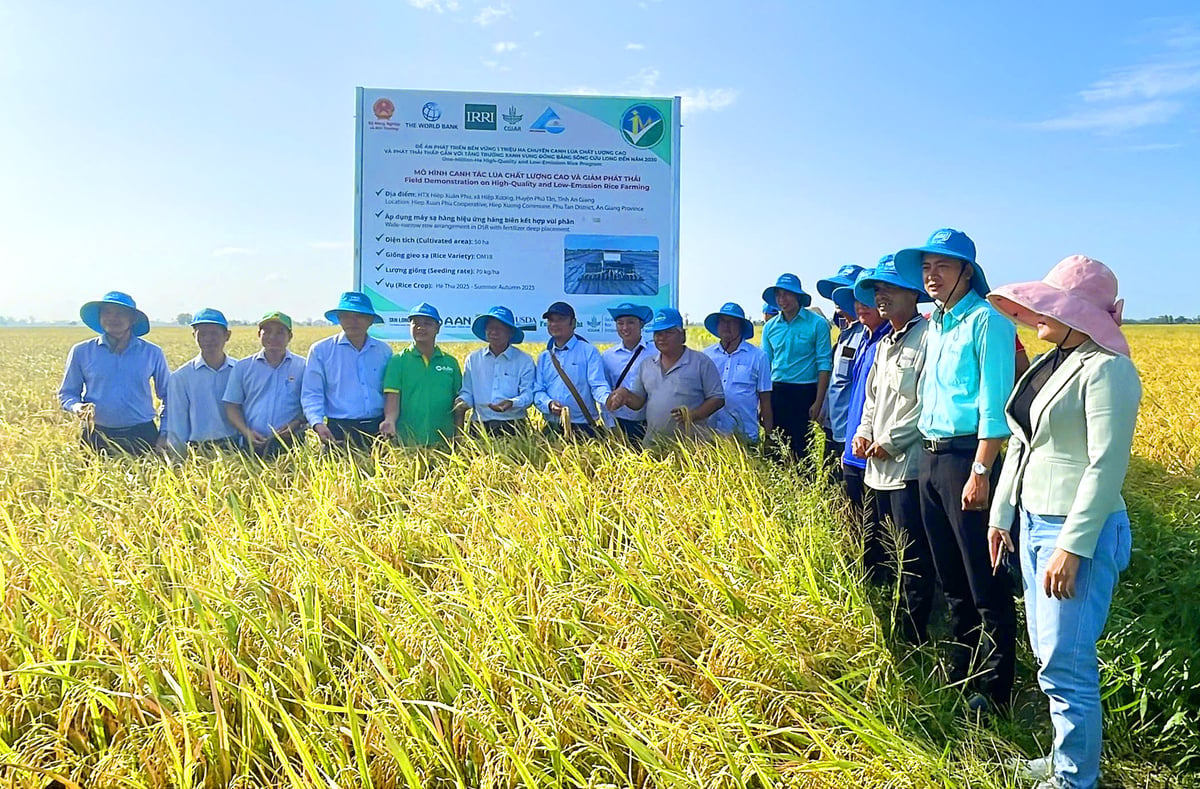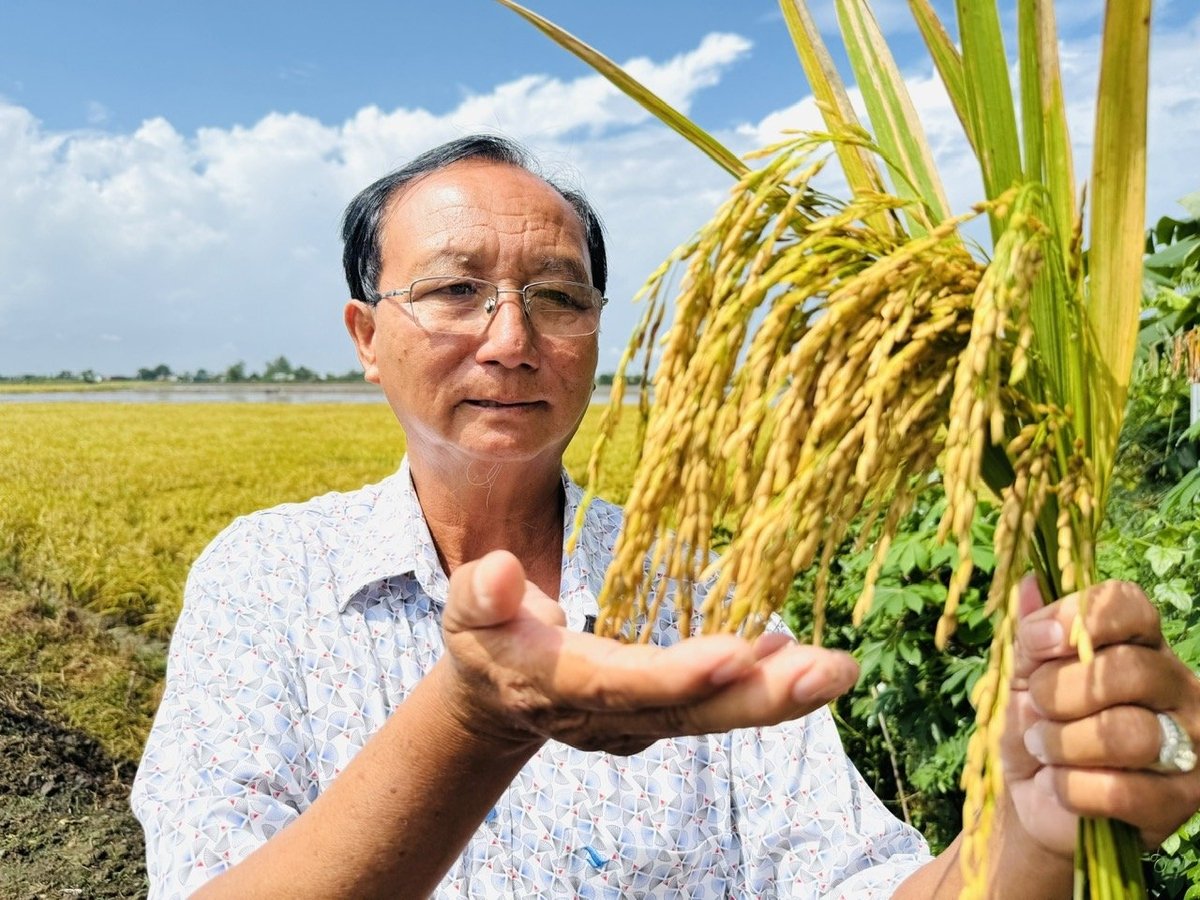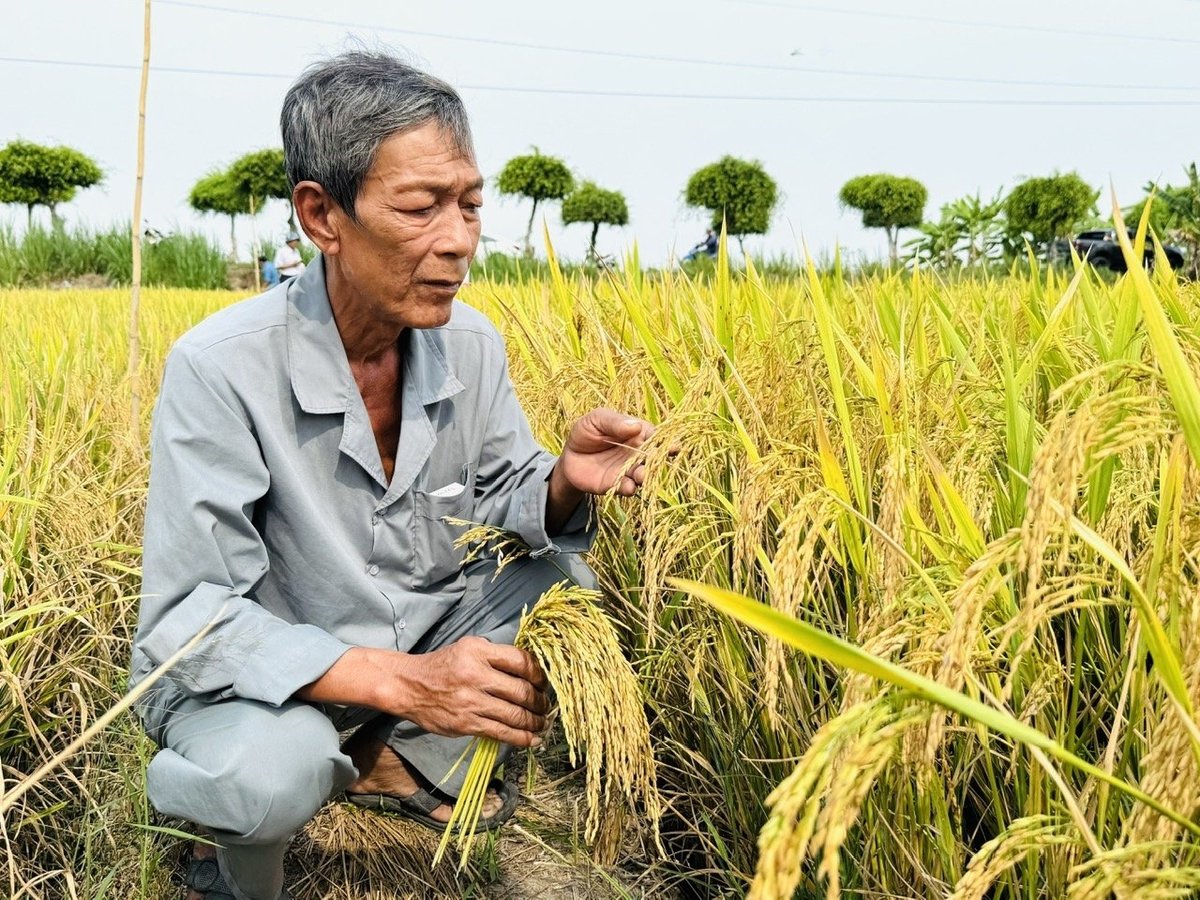December 8, 2025 | 20:52 GMT +7
December 8, 2025 | 20:52 GMT +7
Hotline: 0913.378.918
December 8, 2025 | 20:52 GMT +7
Hotline: 0913.378.918
The initiative, which incorporates advanced farming techniques, has led to healthier rice plants, a remarkable recovery of paddy field ecosystems, and a substantial reduction in emissions. Farmers participating in the program have reported an average profit increase exceeding 10 million VND per hectare.

Representatives of the agricultural sector, businesses and farmers visit the model in Hiep Thanh hamlet, Binh Thanh Dong commune, An Giang province. Photo: Le Hoang Vu.
The innovative model employs a range of practices, including direct dry seeding with fertilizer incorporation, alternate wetting and drying (AWD) for water management, integrated pest management (IPM), and the use of organic bio-fertilizers.
On August 1, a conference was held in Hiep Thanh Hamlet, Binh Thanh Dong Commune, An Giang Province, to review the successes of the high-quality, reduced-emission rice cultivation model. The event was jointly organized by the An Giang Department of Agriculture and Environment and several key input suppliers: Binh Dien Fertilizer Joint Stock Company, Tu Sang Agricultural Machinery Company, Tan Thanh Trading Co., Ltd., and An An Food Joint Stock Company. The model is a crucial component of the "One million hectare of high-quality, low-emission rice specialization area" project in the Mekong Delta.
Representatives from the agricultural sector, businesses, and local farmers attended the conference, which included a field visit to the model site in Hiep Thanh Hamlet.
Launched during the 2025 Summer-Autumn crop, the pilot model spanned 50 hectares and involved 11 participating households. This pilot serves as a vital step in evaluating the practical effectiveness of advanced cultivation techniques, laying the groundwork for future expansion.

Rice in the model gives a profit of more than 19.3 million VND/ha, nearly double that of traditional farming fields. Photo: Le Hoang Vu.
According to Mr. Nguyen Van Hien, Head of the An Giang Department of Crop Production and Plant Protection, the model fully adhered to the technical guidelines of the One Million Hectare Rice Project. This included practices such as direct dry seeding with fertilizer incorporation, using certified OM18 rice varieties, applying fertilizer based on a leaf color chart, implementing alternate wetting and drying (AWD) for water management, adopting integrated pest management (IPM), and utilizing organic bio-fertilizers.
Mr. Hien noted that the An Giang agricultural sector highly commends the model's effectiveness. The application of sparse seeding techniques, precise fertilization, and rational water management not only fosters robust rice plant growth but also significantly contributes to reducing greenhouse gas emissions. The model achieved a rice yield of 6.36 tons per hectare, surpassing control fields by 0.76 tons per hectare. Furthermore, profits increased by over 10 million VND per hectare compared to non-model fields, with a notable reduction in input material costs.
Mr. Pham Huu Chi, one of the 11 participating farmers, shared his positive experience: "I cultivated 2 hectares following the model's technical procedures. Previously, I would sow 150-200 kg of seeds per hectare. Now, I've reduced it to 70 kg per hectare, yet the rice plants are still healthy, have fewer pests and diseases, don't lodge, and I save on seeds, irrigation water, fertilizers, and even pesticides. This season, I've observed that the rice ripened uniformly, yields are higher than before, and profits have increased significantly."
Rice cultivated under the model generated a profit of over 19.3 million VND per hectare, nearly double that of traditionally farmed fields. Mr. Chi expressed his deep satisfaction with the enthusiastic technical support provided by agricultural officials from both the commune and province. When his rice encountered blast disease during panicle initiation, technical officers closely monitored the situation daily and guided timely treatment, averting significant losses and instilling confidence among the participating farmers.
The conference report highlighted substantial cost savings, including 2.1 million VND per hectare in seed costs, 1.57 million VND per hectare in pesticide costs, nearly 700,000 VND per hectare in fertilizer costs, and reduced labor due to uniform seeding and easier maintenance.

Farmers participating in the model are very excited because the rice harvest is good and the price is good. Photo: Le Hoang Vu.
Overall, total costs decreased by nearly 4.9 million VND per hectare, while total revenue increased by over 5.3 million VND per hectare. Net profit reached over 19.3 million VND per hectare, almost double that of traditional farming methods (which yielded only 9 million VND per hectare). Production costs also fell from 5,482 VND per kilogram to 4,060 VND per kilogram.
Mr. Tran Thanh Hiep, Deputy Director of the An Giang Department of Agriculture and Environment, stated: "This model not only enhances economic efficiency but also actively contributes to the goal of reducing greenhouse gas emissions, moving towards sustainable agriculture. Sparse seeding, rational water management, and reduced chemical usage have led to the restoration of the paddy field ecosystem, with a marked increase in natural predators”.
Farmers involved in the model are reportedly thrilled with the successful harvest and favorable prices. The model has not only boosted farmers' incomes but also paved the way for environmentally friendly rice production, meeting both domestic and international market standards. The provision of seeds, bio-fertilizers, and technical support from relevant agencies has also empowered farmers to transition from traditional farming practices to modern, eco-friendly procedures.
Significantly, the model has organized technical training sessions for farmers, both within and outside the program, providing knowledge on climate change, paddy field ecosystems, emission reduction techniques, and procedures for obtaining planting area codes. This is a vital prerequisite for An Giang rice to enter high-quality export markets.
Mr. Tran Thanh Hiep emphasized that the conference in Hiep Thanh Hamlet was not merely an occasion to review the results of a single season but also the beginning of a long-term development strategy for An Giang province's rice sector. The model's success is measured not only by profit figures but also by farmers' new cultivation mindsets, the agricultural sector's ongoing support, and the close collaboration with input suppliers. This forms a crucial foundation for the One million hectare project in An Giang to achieve its objectives.
Translated by Linh Linh
![Hue aims for Net Zero: [5] Building a green and sustainable city](https://t.ex-cdn.com/nongnghiepmoitruong.vn/608w/files/content/2025/12/03/bai-5-anh-6-105459_830-111605.jpg)
(VAN) Hue City continues its efforts to build and maintain a green, sustainable, and environmentally friendly city, joining the Government in pursuing the goal of Net Zero by 2050.

(VAN) After 10 years of operation, Aus4Skills has awarded more than 500 scholarships and enhanced the skills of over 40,000 students, contributing to the strengthening of the strong relationship between the two countries.
![Hue aims for Net Zero: [4] The effectiveness of ERPA payments](https://t.ex-cdn.com/nongnghiepmoitruong.vn/608w/files/content/2025/12/02/bai-4-anh-1-103726_244-093242.jpg)
(VAN) In Hue City, ERPA payments have proven highly effective, serving as a green finance tool that helps reduce carbon and greenhouse-gas emissions and move closer to the Net Zero target.

(VAN) At the TARASA25 Conference, participating countries shared experiences on implementing agroecology and regenerative agriculture, contributing to a sustainable transformation of food and agriculture systems.

(VAN) Green industry is becoming a driving force for the development of Hue City, not only promoting economic growth but also protecting the environment, creating the foundation for the Net Zero goal.

(VAN) As of 2025, the ASEAN region has a total of 69 ASEAN Heritage Parks recognized across its 10 member states. Among them, Viet Nam contributes 15 ASEAN Heritage Parks.

(VAN) Yok Don National Park has high biodiversity with numerous endemic plant and animal species, and it is also the only dipterocarp forest ecosystem conservation area in Viet Nam.